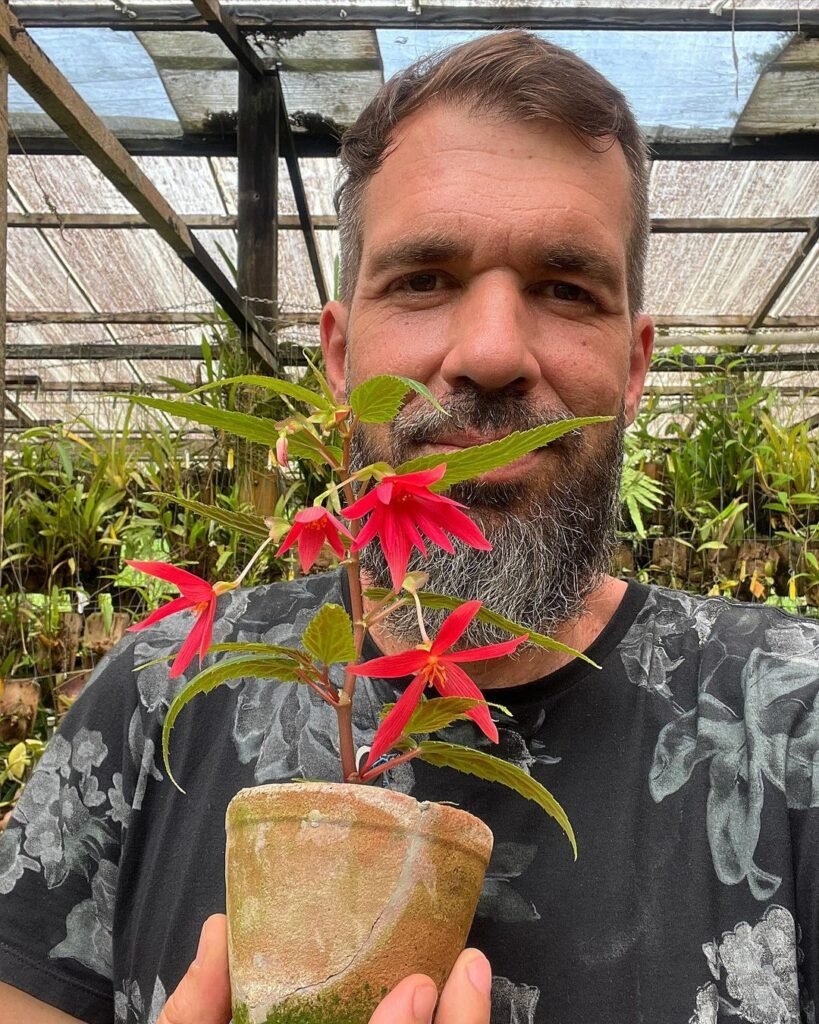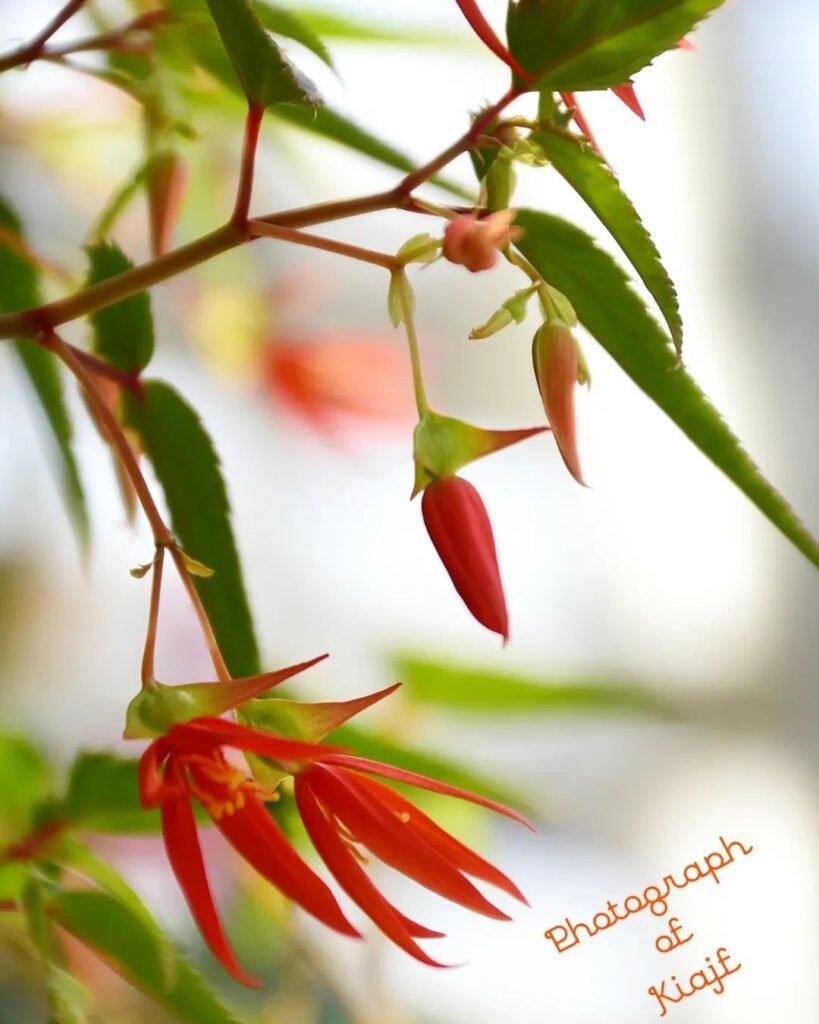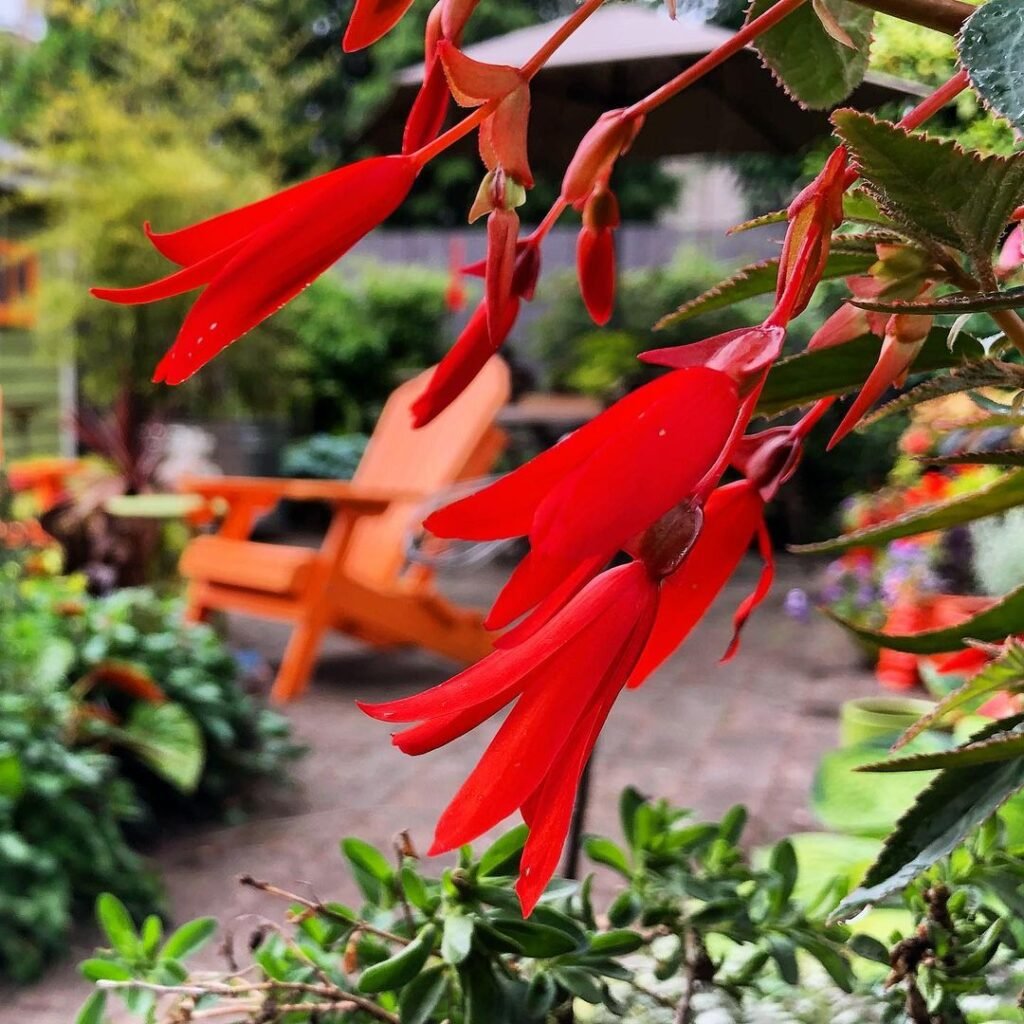Begonia Boliviensis, also known as Bolivian Begonia, is a stunning and unique flowering plant that belongs to the Begoniaceae family. This captivating species is native to the high-altitude regions of Bolivia and, as such, is accustomed to slightly cooler temperatures than some other begonia varieties.
Origin and Historical Significance
Begonia Boliviensis was first discovered in the early 19th century by French botanist Aimé Bonpland during his exploration of South America. Since its introduction to horticulture, it has gained immense popularity due to its elegant, tubular-shaped flowers that bloom profusely.
Key Features of Begonia Boliviensis
Before delving into care tips and requirements, let’s take a closer look at the distinctive features that make Begonia Boliviensis stand out:
- Tubular Flowers: One of the most striking attributes of this begonia is its elongated, tubular flowers that hang gracefully, adding an exquisite touch to your garden or indoor space.
- Vibrant Colors: These charming flowers come in a variety of vibrant colors, including shades of red, orange, and yellow, making Begonia Boliviensis a favorite among garden enthusiasts.
- Trailing Growth Habit: Begonia Boliviensis has a trailing growth habit, which makes it ideal for hanging baskets, window boxes, or cascading over the edges of containers.



Genus Species
Understanding the genus and species of Begonia Boliviensis can provide valuable insights into its classification and genetic traits. This knowledge can be helpful when tailoring your care strategies.
Taxonomical Classification
- Genus: Begonia
- Species: Boliviensis
Subspecies and Varieties
Within the species Boliviensis, there are several recognized subspecies and cultivated varieties, each with its own unique characteristics. Some popular selections include Begonia Boliviensis ‘Bonfire’ and Begonia Boliviensis ‘Santa Cruz.’
Begonia Boliviensis Appearance



The visual appeal of Begonia Boliviensis is undeniably captivating, making it a sought-after choice for gardens and indoor plant collections.
Foliage and Leaves
Begonia Boliviensis boasts delicate, asymmetrical leaves that are often glossy and deep green. These leaves provide a striking contrast to the vibrant flowers, adding to its overall charm.
Flowers
As mentioned earlier, the hallmark of Begonia Boliviensis is its mesmerizing, pendulous flowers. They resemble tiny lanterns and come in various colors, depending on the specific variety. From the vivid reds to sunny yellows, these flowers are sure to catch the eye.
Table: Common Colors of Begonia Boliviensis Flowers
| Variety | Flower Colors |
|---|---|
| ‘Bonfire’ | Bright red, fiery orange |
| ‘Santa Cruz’ | Rich scarlet, deep orange |
| ‘Boliviensis Red’ | Vibrant red, hints of pink |
| ‘Boliviensis Orange’ | Bold orange, warm and inviting |
| ‘Boliviensis Yellow’ | Sunny yellow, cheerful |
These vibrant flowers not only attract humans but also draw pollinators like butterflies and hummingbirds, making your garden come alive with activity.
Not the plant for you? Check out my full list of 78 Types of Begonia!
Begonia Boliviensis Care Tips
Now that you have a clearer picture of what Begonia Boliviensis is and its beautiful appearance, let’s delve into the care tips to ensure your begonia thrives in your chosen environment.
Selecting the Right Location
Begonia Boliviensis thrives in bright, indirect light. Choose a spot that receives filtered sunlight or dappled shade, especially during the hotter parts of the day. It’s essential to protect it from scorching, direct sun, which can cause leaf burn.
Indoor and Outdoor Considerations
- Indoors: Place your Begonia Boliviensis near east or north-facing windows where it can enjoy the gentle morning or filtered sunlight.
- Outdoors: For outdoor cultivation, consider planting it beneath taller plants or in shaded areas with well-draining soil.
Soil and Potting Mix
The choice of soil is crucial for Begonia Boliviensis. It thrives in well-draining soil with a slightly acidic to neutral pH. A mix rich in organic matter, such as peat moss or compost, is ideal. Consider a potting mix designed for begonias, which typically meets these requirements.
Pot Selection
When growing Begonia Boliviensis in containers, opt for pots with good drainage holes to prevent waterlogging, as this plant is sensitive to overwatering.
Stay tuned for the next sections covering light and soil requirements, watering, and humidity and temperature considerations to ensure your Begonia Boliviensis thrives.
Begonia Boliviensis Light and Soil Requirements
Proper lighting and soil conditions are vital for the well-being of your Begonia Boliviensis. Here’s a comprehensive guide to meet these requirements.
Light Requirements
- Indirect Bright Light: Begonia Boliviensis thrives in bright, indirect light. It’s essential to avoid direct sunlight, which can scorch its delicate leaves.
- Indoor Considerations: Place your indoor begonia near east or north-facing windows, allowing it to bask in gentle morning or filtered sunlight. If you’re growing it in a room with limited natural light, consider using fluorescent grow lights to supplement its lighting needs.
Soil Requirements
- Well-Draining Soil: Begonia Boliviensis prefers well-draining soil to prevent waterlogged roots. A mix that includes peat moss, perlite, and compost works well.
- Acidic to Neutral pH: Maintain a soil pH level between slightly acidic and neutral (pH 6.0-7.0) for optimal growth. You can use a pH testing kit to monitor and adjust the soil acidity.

Fertilizing Begonia Boliviensis
Fertilizing your Begonia Boliviensis is crucial to ensure it receives the necessary nutrients for healthy growth and abundant flowering.
When to Fertilize
- During the Growing Season: Fertilize your Begonia Boliviensis during its active growing season, which typically occurs in spring and summer.
- Frequency: Apply a balanced, water-soluble fertilizer every 2-4 weeks. Reduce the frequency during the dormant winter period.
Fertilizer Selection
- Balanced NPK: Choose a balanced fertilizer with equal or near-equal amounts of nitrogen (N), phosphorus (P), and potassium (K), like a 10-10-10 or 20-20-20 formulation.
- Micronutrients: Begonia Boliviensis benefits from micronutrients, so consider a fertilizer that includes trace elements such as iron, magnesium, and calcium.
Common Water-Soluble Fertilizer NPK Values
| Fertilizer Type | N-P-K Ratio | Additional Info |
|---|---|---|
| General Purpose | 10-10-10 | Suitable for most garden plants |
| Bloom Booster | 15-30-15 | Enhances flowering and bud formation |
| All-Purpose Liquid | 8-8-8 | Provides nutrients for overall plant health |
Begonia Boliviensis Pruning and Shaping



Proper pruning and shaping are essential for maintaining the Begonia Boliviensis’ attractive appearance and controlling its growth.
Regular Pruning
- Deadhead Spent Flowers: To encourage continuous blooming, remove faded or spent flowers regularly. This process redirects the plant’s energy to produce new blooms.
- Pinch Back Leggy Growth: If your begonia becomes leggy, meaning it has long stems with sparse foliage, pinch back the tips to encourage branching and a bushier appearance.
Shaping Techniques
- Control Size: To maintain a compact size, you can trim the longer stems and remove overgrown branches. This is especially important for indoor begonias with limited space.
- Cascading Effect: If you want your Begonia Boliviensis to have a more cascading appearance, allow it to grow naturally and trim only to manage its size and remove unhealthy growth.
Begonia Boliviensis Propagation and Repotting
As your Begonia Boliviensis thrives and matures, you may consider propagation and repotting to ensure its continued health and vitality.
Propagation Methods
- Leaf Cuttings: Begonia Boliviensis can be propagated from leaf cuttings. Select a healthy leaf, cut it into sections with veins, and place them in a suitable rooting medium until they develop roots and can be planted in new containers.
- Division: Mature begonias can be divided by gently separating the root ball into smaller sections, each with a healthy stem and root system. Replant these divisions in new pots.
Repotting Guidelines
- Timing: Repot your Begonia Boliviensis every 2-3 years or when it becomes root-bound. Spring is usually the best time for repotting.
- Choose the Right Pot: Select a slightly larger pot with good drainage for repotting. Ensure the new container has enough space for the plant’s growth.
Stay tuned for the next sections covering seasonal care, companion plants, pest control tips, and how to revive a sick or wilting Begonia Boliviensis.
Begonia Boliviensis Seasonal Care
Understanding the seasonal care requirements for Begonia Boliviensis is essential to ensure it remains healthy and vibrant throughout the year.
Spring
- Rejuvenation: Spring is the time for rejuvenation. Remove any dead or damaged growth and consider repotting if the plant has outgrown its current container.
- Fertilization: Begin regular fertilization in early spring to support active growth.
Summer
- Optimal Conditions: Begonia Boliviensis thrives in summer, but be cautious of extreme heat. Ensure it receives sufficient water and protection from intense sun.
- Deadheading: Continue deadheading to promote continuous flowering.
- Hydration: Water regularly to keep the soil consistently moist but not waterlogged.
Fall
- Preparing for Dormancy: As the days get shorter, your Begonia Boliviensis may enter a semi-dormant state. Reduce fertilization and decrease watering, allowing the soil to dry slightly between waterings.
- Bring Indoors: If grown outdoors, consider bringing your begonia indoors as temperatures drop, as it’s sensitive to frost.
Winter
- Dormancy: Begonia Boliviensis experiences a period of dormancy in winter. Reduce watering to prevent root rot and avoid fertilization.
- Indoor Care: If you have an indoor plant, place it in a cool, well-ventilated area with reduced light. Be patient, as it may not bloom during this period.
Begonia Boliviensis Companion Plants
Choosing the right companion plants for your Begonia Boliviensis can enhance its visual appeal and create a harmonious garden design.
Shade-Loving Companions
- Impatiens (Impatiens walleriana): These colorful annuals thrive in the same shade conditions as Begonia Boliviensis and offer a variety of vibrant flower colors.
- Fuchsia (Fuchsia spp.): Fuchsia’s pendulous, tubular flowers complement the begonia’s appearance and add an extra layer of elegance.
Container Garden Partners
- Coleus (Solenostemon scutellarioides): Coleus varieties with colorful foliage create a striking contrast when potted with Begonia Boliviensis.
- Lobelia (Lobelia erinus): Compact and trailing lobelias complement the cascading growth of your begonia in containers.
Ground Cover Options
- Vinca (Catharanthus roseus): Vinca’s low-growing, spreading habit makes it an ideal ground cover around Begonia Boliviensis in garden beds.
- Hosta (Hosta spp.): These perennial plants with textured foliage provide an appealing backdrop to your begonia.
| Companion Plant | Sunlight Requirements | Features |
|---|---|---|
| Impatiens | Partial to full shade | Colorful and easy to grow |
| Fuchsia | Partial to full shade | Elegant tubular flowers |
| Coleus | Partial to full shade | Vibrant, variegated foliage |
| Lobelia | Partial to full shade | Trailing, compact growth |
| Vinca | Partial to full shade | Low-growing ground cover |
| Hosta | Partial to full shade | Textured foliage |
Choosing the right companions for your Begonia Boliviensis will not only enhance its beauty but also create a balanced and appealing garden or container display.
Pest Control Tips for Begonia Boliviensis



Keeping your Begonia Boliviensis free from pests is crucial for its overall health and appearance. Here are effective pest control strategies.
Common Pests
- Aphids: These tiny, soft-bodied insects can be controlled by spraying a mild soapy solution or using neem oil.
- Mealybugs: Mealybugs are known for their white, waxy appearance. Use a cotton swab dipped in alcohol to remove them.
Preventative Measures
- Inspect Regularly: Regularly check your begonia for signs of pests, including distorted leaves, honeydew residue, or visible insects.
- Isolation: Isolate any newly acquired plants for a few weeks to ensure they are pest-free before placing them near your Begonia Boliviensis.
Natural Predators
- Ladybugs: Encourage ladybugs in your garden as they are natural predators of aphids and other small pests.
- Beneficial Nematodes: These microscopic organisms can help control soil-dwelling pests.
By implementing these pest control tips, you can maintain a pest-free and healthy Begonia Boliviensis.

Reviving a Sick or Wilting Begonia Boliviensis
When your Begonia Boliviensis shows signs of distress, it’s essential to take immediate action to revive it and restore its vitality.
Identify the Issue
- Wilting Leaves: If your begonia’s leaves are wilting, it may be suffering from underwatering or root rot. Check the soil moisture and drainage.
- Yellowing Leaves: Yellow leaves can be a sign of overwatering or nutrient deficiencies. Assess the soil condition and feeding schedule.
Pruning and Trimming
- Remove Unhealthy Growth: Trim and remove any unhealthy or dead leaves, stems, or flowers to redirect energy to healthier parts of the plant.
- Shape and Encourage New Growth: Pruning can help stimulate new growth and reshape your begonia.
Adjust Care Practices
- Watering: Ensure proper watering, allowing the soil to slightly dry between waterings. Adjust your watering schedule according to the plant’s needs.
- Fertilization: Evaluate your fertilization routine and consider applying a balanced, water-soluble fertilizer to provide the necessary nutrients.
Love all types of Begonia? Make sure to catch up on my post on how to care and grow for begonia ferox. After you’ve finished reading that, why not also check out my care guide on how to grow begonia melanobullata.
Conclusion
In conclusion, Begonia Boliviensis is a captivating and rewarding addition to your garden or indoor plant collection. Its distinctive tubular flowers, vibrant colors, and trailing growth habit make it a standout choice for those who appreciate the beauty of begonias. To ensure your Begonia Boliviensis thrives, remember the following key points:
- Provide the right amount of bright, indirect light, protecting it from harsh sunlight.
- Choose well-draining, slightly acidic to neutral soil for optimal growth.
- Fertilize during the growing season with a balanced, water-soluble fertilizer.
- Practice regular pruning and shaping to maintain its attractive appearance.
- Adjust care according to the seasons to meet its changing needs.
With proper care and attention, your Begonia Boliviensis can flourish and delight you with its charming blooms for years to come.
FAQs
What should I do if my Begonia Boliviensis is dropping its leaves?
Leaf drop in Begonia Boliviensis can be caused by various factors, including overwatering, underwatering, or temperature fluctuations. First, check the moisture level of the soil. Ensure it’s consistently moist but not waterlogged. Also, verify that your plant is not exposed to cold drafts or extreme temperature changes. Adjusting watering practices and maintaining stable environmental conditions can often help address leaf drop.
Can I grow Begonia Boliviensis indoors?
Absolutely, Begonia Boliviensis can thrive indoors. Place it near east or north-facing windows where it can receive bright, indirect light. Be mindful of maintaining the right soil conditions and humidity levels. Indoor begonias may require more attention to humidity, as indoor air can be dry. You can use a humidity tray or a room humidifier to create a more suitable environment.
How often should I fertilize my Begonia Boliviensis?
During the growing season, which typically occurs in spring and summer, you should fertilize your Begonia Boliviensis every 2-4 weeks. Use a balanced, water-soluble fertilizer with micronutrients. Reduce or eliminate fertilization during the dormant winter period when the plant’s growth slows down.
Can Begonia Boliviensis tolerate full sun?
Begonia Boliviensis is sensitive to direct sunlight, especially in hot regions. It’s best to provide bright, indirect light and avoid exposing it to prolonged periods of intense sun. In regions with milder climates, it may tolerate some morning sun but should be protected from harsh afternoon sunlight.
How can I propagate Begonia Boliviensis from leaf cuttings?
To propagate Begonia Boliviensis from leaf cuttings, select a healthy leaf and cut it into sections, ensuring each section has prominent veins. Place these cuttings in a suitable rooting medium, like a mix of perlite and peat moss. Keep the cuttings in a humid environment with indirect light until they develop roots. Once the roots are established, you can transplant them into new containers or the garden.

Writer/Green Thumb/Explorer – Rooted deep in the rich soils of Devon, I’ve cultivated a vast expertise in plant care, helping greenery thrive in homes across the UK. When I’m not crafting detailed plant care guides, I’m journeying through the lush landscapes of the West Country, unearthing nature’s secrets and sharing them with fellow plant enthusiasts. Every leaf has a story, and I’m here to tell it.





